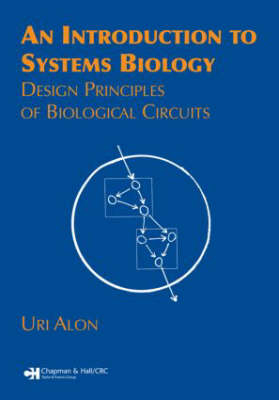
An Introduction to Systems Biology
Chapman & Hall/CRC (Verlag)
978-1-58488-642-6 (ISBN)
- Titel erscheint in neuer Auflage
- Artikel merken
Thorough and accessible, this book presents the design principles of biological systems, and highlights the recurring circuit elements that make up biological networks. It provides a simple mathematical framework which can be used to understand and even design biological circuits. The textavoids specialist terms, focusing instead on several well-studied biological systems that concisely demonstrate key principles. An Introduction to Systems Biology: Design Principles of Biological Circuits builds a solid foundation for the intuitive understanding of general principles. It encourages the reader to ask why a system is designed in a particular way and then proceeds to answer with simplified models.
INTRODUCTION
TRANSCRIPTION NETWORKS, BASIC CONCEPTS
Introduction
The Cognitive Problem of the Cell
Elements of Transcription Networks
Dynamics and Response Time of Simple Gene Circuits
AUTO-REGULATION, A NETWORK MOTIF
Introduction
Patterns, Randomized Networks and Network Motifs
Autoregulation is a Network Motif
Negative Auto-Regulation Speeds the Response Time of Gene
Circuits
Negative Auto-Regulation Promotes Robustness to Fluctuations
in Production
Positive auto-regulation speeds responses and widens cell-cell variability
Summary
THE FEEDFORWARD LOOP NETWORK MOTIF
Introduction
The Number of Appearances of a Subgraph in Random
Networks
The Feedforward Loop (FFL) is a Network Motif
The Structure of the Feedforward Loop Circuit
Dynamics of the Coherent FFL with AND-Logic
The C1-FFL is a Sign-Sensitive Delay Element
The Incoherent FFL: a pulse generator and response accelerator
Why Are Some FFL Types Rare?
Convergent Evolution of FFLs
Summary
TEMPORAL PROGRAMS AND THE GLOBAL STRUCTURE OF TRANSCRIPTION NETWORKS
Introduction
The Single-Input Module (SIM) Network Motif
SIMs Can Generate Temporal Expression Programs
Topological Generalizations of Network Motifs
The Multi-Output FFL Can Generate FIFO Temporal Order
Signal Integration and Combinatorial Control: Bi-Fans and
Dense-Overlapping Regulons
Network Motifs and the Global Structure of Sensory
Transcription Networks
NETWORK MOTIFS IN DEVELOPMENTAL, SIGNAL-TRANSDUCTION AND NEURONAL NETWORKS
Introduction
Network Motifs in Developmental Transcription Networks:
Positive feedback loops and bistability
Motifs in Signal Transduction Networks
Information Processing Using Multi-Layer Perceptrons
Composite Network Motifs: Negative Feedback and Oscillator
Motifs
Network Motifs in the Neuronal Network of C. Elegans
Summary
ROBUSTNESS OF PROTEIN CIRCUITS, THE EXAMPLE OF BACTERIAL CHEMOTAXIS
The Robustness Principle
Bacterial Chemotaxis, or How Bacteria 'Think'
The Chemotaxis Protein Circuit of E. coli
Two Models Can Explain Exact Adaptation, One is Robust and
the Other Fine Tuned
The Barkai-Leibler model
Individuality and Robustness in Bacterial Chemotaxis
ROBUST PATTERNING IN DEVELOPMENT
Introduction to Morphogen Gradients
Exponential Gradients Are Not Robust
Increased Robustness by Self-Enhanced Morphogen
Degradation
Network Motifs That Provide Robust Patterning
The Robustness Principle Can Distinguish Between
Mechanisms of Fruit Fly Patterning
KINETIC PROOFREADING
Introduction
Kinetic Proofreading of the Genetic Code Can Reduce Error
Rates of Molecular Recognition
Recognition of Self and Non-Self by the Immune System
Kinetic Proofreading May Occur in Diverse Recognition
Processes in the Cell
OPTIMAL GENE CIRCUIT DESIGN
Introduction
Cost and Benefit Analysis of Gene circuits
Optimal Expression Level of a Protein Under Constant
Conditions
To Regulate or Not to Regulate: Optimal Regulation in Variable
Environments
Environmental Selection of the Feedforward Loop Network Motif
Summary
RULES FOR GENE REGULATION BASED ON ERROR MINIMIZATION
Introduction
The Savageau Demand Rules
Rules for Gene Regulation Based on Minimal Error Load
Demand Rules for Genes with Multiple Regulators
Summary
EPILOGUE: Simplicity in Biology
APPENDIX A: The Input-Function of a Gene, Michaelis-Menten and Hill Equations
APPENDIX B: Multi-Dimensional Input-Functions
APPENDIX C: Graph Properties of Transcription Networks
APPENDIX D: Cell-Cell Variability in Gene Expression
GLOSSARY
BIBLIOGRAPHY
| Erscheint lt. Verlag | 7.7.2006 |
|---|---|
| Reihe/Serie | Chapman & Hall/CRC Mathematical and Computational Biology |
| Zusatzinfo | 4 pg color insert follows pg 112; 4 Halftones, black and white; 8 Tables, black and white; 110 Illustrations, black and white |
| Sprache | englisch |
| Maße | 178 x 254 mm |
| Gewicht | 680 g |
| Themenwelt | Naturwissenschaften ► Biologie |
| ISBN-10 | 1-58488-642-0 / 1584886420 |
| ISBN-13 | 978-1-58488-642-6 / 9781584886426 |
| Zustand | Neuware |
| Informationen gemäß Produktsicherheitsverordnung (GPSR) | |
| Haben Sie eine Frage zum Produkt? |
aus dem Bereich



